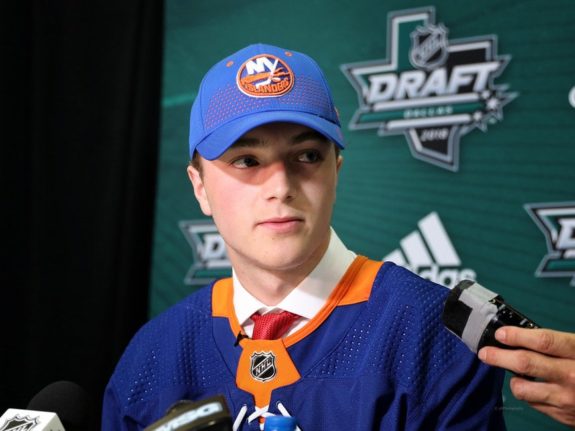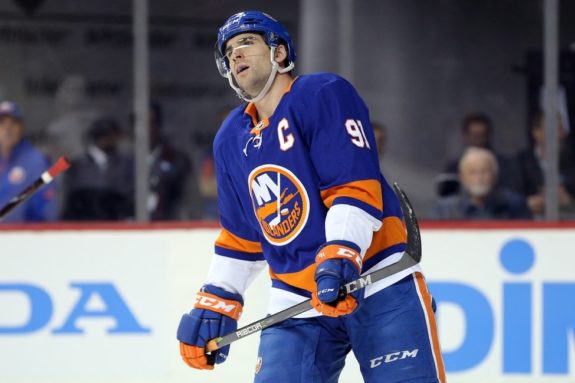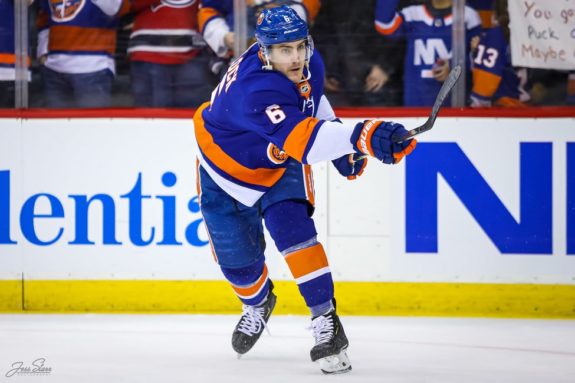After much speculation at the time, the New York Islanders traded longtime defenseman Travis Hamonic to the Calgary Flames at the 2017 NHL Draft. Even though Hamonic was a solid defenseman for the Islanders, the team needed a shakeup after missing the 2017 playoffs. Also, it’s worth mentioning that Hamonic had previously requested a trade from the Islanders to a team near his hometown (Manitoba) due to family circumstances. However, he later rescinded the request after the situation was resolved.
The Return for Hamonic
Considering that Garth Snow acquired Jordan Eberle a couple of days after trading away Hamonic, fans didn’t have much time to complain about the return of only three draft picks. The Islanders acquired a 2018 second-round pick (43rd overall), a 2019 second-round pick (57th overall), and a 2018 first-round pick (12th overall). The two second-round picks were used on forward Ruslan Iskhakov and defenseman Samuel Bolduc. However, the highlight of the trade was the first-round pick, which was used to draft stud defenseman Noah Dobson.

Given the fact that Dobson made his NHL debut at only 19 years old this season, it’s safe to say that the pick has worked out for the Islanders. Also, it’s even better that the other two players drafted with the picks are well-regarded throughout the organization. Ruslan Iskhakov is known as a reliable winger who can put the puck in the net when needed to. He currently as 21 points through 32 games this season for the University of Connecticut Huskies.
As for Bolduc, he is currently having an outstanding season in the QMJHL, where he has 43 points in 61 games for the Blainville-Boisbriand Armada and the Sherbrooke Phoenix. Obviously, for a 19-year-old defenseman, these are excellent numbers.
Islanders’ 2017-18 Defensive Struggles Without Hamonic
Although his name didn’t come up too much during the Islanders’ dreadful 2017-18 season, Hamonic was sorely missed on the blue line. Despite the fact that they had a plethora of offensive talent, which included a Calder-winning season from Mathew Barzal and the last season as an Islander for John Tavares, the Islanders’ defense and goaltending couldn’t get their acts together.

On the other side of things, Hamonic didn’t have a great inaugural season with the Flames. He only put up 11 points through 71 games, as well as ending the season with a plus/minus rating of minus nine. Regardless of his play during the 2017-18 season, he still would have helped the Islanders stay strong on defense. It also raises the question of whether or not it played into Tavares’ decision to leave the Islanders.
Related: Bill Torrey – How ‘The Architect’ Constructed a Dynasty
Obviously, Hamonic himself had nothing to do with Tavares’ decision, but maybe if he was there to help the Islanders that season they wouldn’t have been as bad as they were, which could’ve caused Tavares to re-think his decision to leave the team where he spent nine seasons. Even though the departure of Hamonic probably had no effect on Tavares’ decision, it’s interesting to think about how deep this trade really went in terms of long-term effects on the organization.
Long-Term Effects of the Trade
As the trade’s three year anniversary approaches, the question must be asked: are the Islanders better off today without Hamonic? The answer is yes. Without counting the two second-round selected prospects that the Islanders have from the trade, they already have a better defenseman than Hamonic in Dobson, who is only 20 years old. Also, the Islanders have the rest of their defense core which is, and will continue to be, one of the best in the league for years to come. Lead by a young group of Adam Pelech, Ryan Pulock, Devon Toews, Dobson, and Scott Mayfield the Islanders are set on defense.

The Islanders’ abundance of good defenseman also comes in handy because it allows for Nick Leddy to become expendable this offseason for some badly needed offensive talent, which is partly thanks to the Islanders acquiring the pick that was used for Dobson in the Hamonic trade.
The Travis Hamonic deal is a great example of how a single move can have small effects on an organization for many years.